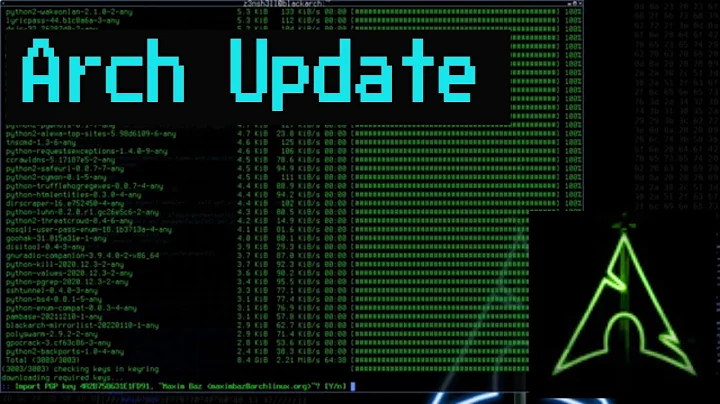AMD-VI: completion wait loop after a failed install of Arch Linux on a blank SSD
Solution 1
Linux Kernel With MSI B450
The kernel fail in this case because of the support of the iommu feature; you can use some specific kernel adjustment (parameter) to fix your booting issue, this video demonstrate how to edit/apply the kernel parameters; here are some possibles solutions, try the different proposed parameters and choose the one that match best your needs. also you may turn off SVE in the bios.
Possible Solutions: Kernel Parameters
iommu=off-
iommu=offandamd_iommu=fullflush amd_iommu=offmem_encrypt=offamdgpu.runpm=0pci=noats
Involved Technology Definition
Kernel Parameters: (aka Boot Options) Kernel command line parameters are parameters that you pass on to the kernel during the boot process to adjust its features or capabilities.
IOMMU: is a memory management unit that basically increase performance and security; additional details can be found here
IOMMU State: on, off or fullflush (detail on the linked article)
mem_encrypt: Add support for Secure Memory Encryption (SME). and defines the memory encryption mask that will be used in subsequent patches to mark pages as encrypted.
amdgpu.runpm=0: disable the graphical power management in the linux kernel (it will be then handled at the hardware/firmware/bios level)
pci=noats: disable PCI Address Translation Services
Note
After the install you will need to be very careful on kernel updates
Advanced technical users may build their own kernel with this or that patch
Arch Boot Disk:
To apply the parameters to the boot disk, on the boot menu, push "tab" to edit the boot command, hit space (to add a space) then write the parameter for instance "iommu=off" without quotes then hit enter to boot
Sources:
launchpad, freedesktop, freedesktop, freedesktop, askubuntu, wikipedia, artofcode, archlinux, linuxfoundation, fclose, youtube, youtube
Solution 2
Add acpi=off or iommu=soft while booting. Both have their disadvantages:
iommu=soft:
Linux can then detect everything properly (all cores) and I've had zero crashes. The only issue is that it's using software IOMMU which could have a performance penalty because it has to copy all the data of some PCI devices to sub 4G regions.
acpi=off:
Alternatively it boots with the kernel option "acpi=off" but only detects a single core/thread.
Resource: https://bugs.launchpad.net/ubuntu/+source/linux/+bug/1747463
To add one of these options, press Tab at the screen that says Press [Tab] to edit options and add it at the end of the line that contains initrd=.
Resource: https://www.reddit.com/r/archlinux/comments/9bv2vj/how_to_add_kernel_parameters_to_boot_from/
If that doesn't work, check and see if there are any available BIOS and/or Arch ISO updates. You might have a better chance of getting it to work if/when Arch includes Linux kernel 5 in their images.
Resource: https://askubuntu.com/a/1091191
Related videos on Youtube
Alok Garg
Updated on September 18, 2022Comments
-
 Alok Garg almost 2 years
Alok Garg almost 2 yearsI am trying to export MongoDB collection data to a CSV or JSON format using Talend, but I am unable to do that, I tried logging rows using tLogRow from tMongoDBInput, but rows are not being displayed, has anyone tried the same, I have MongoDB 3.4, and Talend version I am using is 7.0 TOS for big data.
-
 Pete Cooper about 5 yearsNot directly answering your question -- does your downloaded ISO match the provided checksum(s) in that linked directory?
Pete Cooper about 5 yearsNot directly answering your question -- does your downloaded ISO match the provided checksum(s) in that linked directory?sha1sum archlinux-2019.05.02-x86_64.isowill give you the SHA1 hash, which should bea86b13e041996942529cd7d51405a87ffbb36caa. -
Stephen Kitt about 5 yearsThis looks like one of those bugs with a fix which is good enough to fix the problem, but unfortunately not good enough to be merged into the kernel...
-
Rui F Ribeiro about 5 yearsI would update the BIOS and try a more recent kernel. Another try is enabling legacy mode and disabling AMD SVM, at least during the install phase.
-
 S.S. Anne about 5 yearsRelated: askubuntu.com/questions/1089524/…
S.S. Anne about 5 yearsRelated: askubuntu.com/questions/1089524/… -
Username about 5 years@PeteCooper Checksums match
-
Username about 5 years@StephenKitt I'm a noob so I'm not sure how to apply that code to my situation.
-
Username about 5 years@RuiFRibeiro How would I try a more recent kernel? I'm new at troubleshooting a Linux OS install.
-
 intika about 5 years@Username i posted full detailed answer, that could be understood by anyone ;)
intika about 5 years@Username i posted full detailed answer, that could be understood by anyone ;) -
 ctrl-alt-delor about 5 yearsThis question is hard to read. There are pages in info, before being presented with the question. How are we to know what to do with the info, before we know the question. Putting the question upfront (in the title), will help.
ctrl-alt-delor about 5 yearsThis question is hard to read. There are pages in info, before being presented with the question. How are we to know what to do with the info, before we know the question. Putting the question upfront (in the title), will help.
-
-
Username about 5 yearsFrom the Arch CD menu, how do I get to the point of editing the kernel? Does my blank SSD even have one? Maybe I’m asking the wrong question...
-
 intika about 5 years@Username on the youtube video i linked it should be explained... basically on the grub menu where you select the boot option normally pressing "e" let you edit the menu and "ctrl+x" to boot after writing the modification youtu.be/BdBnVDF8qvQ?t=141
intika about 5 years@Username on the youtube video i linked it should be explained... basically on the grub menu where you select the boot option normally pressing "e" let you edit the menu and "ctrl+x" to boot after writing the modification youtu.be/BdBnVDF8qvQ?t=141 -
Username about 5 yearsI don’t believe I have Grub. I have a blank SSD and anther with Windows 10. My boot option is my CD drive in legacy mode. I tried pressing “e” and “ctrl+x” on the Arch screen but nothing happened.
-
 intika about 5 years@Username boot into your arch cd, push "tab" to edit the boot command, hit space (to add a space) then write the parameter for instance "iommu=off" without quotes then hit enter to boot
intika about 5 years@Username boot into your arch cd, push "tab" to edit the boot command, hit space (to add a space) then write the parameter for instance "iommu=off" without quotes then hit enter to boot




